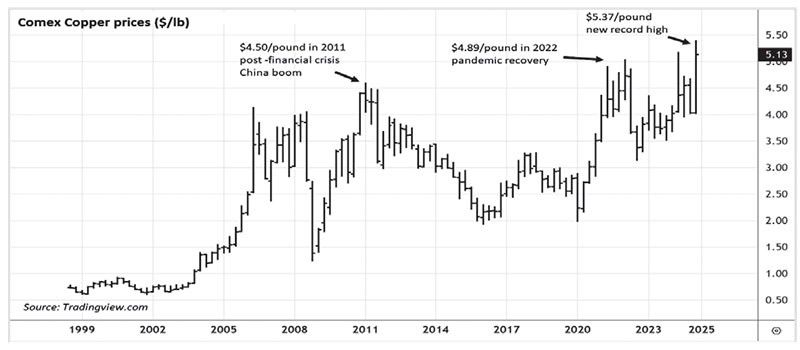Copper soars on tariffs, tech
By Philequity Corner – Wilson Sy | The Philippine Star | March 31, 2025 12:00AM
Copper prices surged to new all-time highs last Wednesday, with Comex futures climbing to $5.37 per pound before settling at $5.13 by Friday’s close. The red metal posted a stunning 27 percent gain in the first quarter of 2025 – its best three-month run since mid-2006 – outshining even gold’s recent milestone above $3,000 (see Gold Surges to 3,000, March 24). Copper’s ascent is driven by a convergence of tariff jitters, booming global demand from electric vehicles (EV), growing requirements from artificial intelligence data centers and a supply squeeze in China, the world’s top consumer.

Trump’s trade tactic shakes market
Last Feb. 25, Trump signed an executive order directing the US Department of Commerce to launch a Section 232 investigation into copper imports. This Cold War-era law authorizes the government to assess whether imports of raw copper, concentrates, refined products, alloys, scraps and derivatives pose threats to national security – a move that could slap 25 percent tariffs on the metal.
While the Department of Commerce officially has 270 days to review, market chatter suggests a decision could drop within weeks. Shipments to the US have surged as traders race to beat potential duties and drained global stockpiles.
Tariff probe sparks a global stockpile rush
New York Comex’s copper spiked as much as five percent early last week, far outpacing London LME’s $9,700 per ton benchmark. The Comex-LME spread, now at its widest ever, reflects the frantic rush to US shores. LME inventories dropped by 18 percent to 117,775 tons in the last four weeks as the metal flowed to American markets ahead of the tariff deadline.
China’s supply squeeze signals bullish move
In China, which consumes half the world’s copper, the market is flashing immediate supply shortages. Shanghai Futures Exchange (ShFE) April contracts have flipped into backwardation – a bullish signal where near-term prices exceed longer-dated ones. ShFE copper stockpiles shrank for a third consecutive week, squeezed by exports to the US, domestic stockpiling and voracious demand from EV production. The Yangshan premium, a barometer of China’s import appetite, jumped by 114 percent this month to $75 per ton, signaling a desperate scramble for supply.
EVs and AI supercharge copper’s long game
Beyond tariffs, copper’s long-term fundamentals are very bullish. EVs, requiring up to 80 kilograms of copper per vehicle, are driving a demand boom with global sales projected to hit 20 million units in 2025. The International Energy Agency projects EV-related copper consumption could surge 12-fold by 2050. Meanwhile, AI’s explosive rise is another key catalyst. Data centers powering large language models consume massive quantities of copper for wiring, power and cooling systems. The US Department of Energy now deems copper “critical” for AI and electrification, warning that supply risks loom without hefty refining upgrades.
Tariffs, tech and tight supply: copper’s next move
Copper’s record-breaking rally is a potent mix of Trump’s tariff threats, dwindling global stockpiles and unrelenting demand from EVs and AI. The metal’s fate now rests on the tariff investigation’s outcome. A steep tariff could ignite New York prices further, deepening the divide with London, while a more sanguine outcome might trigger a sharp pullback. Either way, copper’s role as the backbone of electrification and AI ensures its spotlight won’t dim soon.
Philippines benefit from metals surge
High copper and gold prices bode well for the Philippine mining sector. Philequity Corner has long highlighted the sector’s potential. Record metal prices, coupled with a pro-mining shift under President Marcos have created new financing opportunities. These include streaming (selling future gold production at a discount for immediate cash) and off-take agreements (pre-arranged copper sales for funding).
The CREATE MORE Act (RA 12066) benefits the mining sector through tax incentives and power cost deductions – attracting investment to this capital-intensive sector. Meanwhile, Senate Bill 2826, nearing passage, boosts government revenue share through a graduated windfall tax (one percent to 10 percent) on mining companies during price surges, while encouraging local mineral processing to enhance value creation and generate more jobs.
Source: The Philippine Star
.

